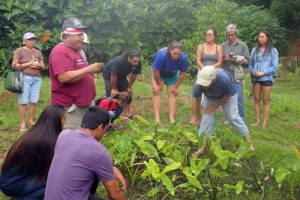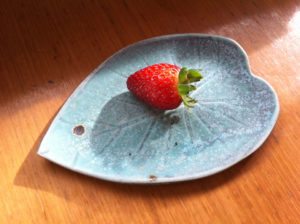Building Maui’s Local Food Movement
Maui is a like a miniature version of the planet, with an incredible diversity of ecosystems and microclimates all packed into one small island. As a result, the options for farmers and gardeners are enormous. Name a food plant, and chances are that it can be grown on Maui. Temperate crops like cabbage, kale, onions and squash all thrive in Kula. Traditional Polynesian staples including taro, sweet potato, breadfruit, and coconut palm are at home in the lowlands of East and West Maui. Tropical fruits like banana, citrus, lychee and mango all like it hot, as do a great variety of lesser known fruits and perennial greens. Delicacies like cherimoya and persimmons find their niche on the slopes of Haleakala, and so do grass-fed cattle and other livestock. The island can also produce more avocados than we can eat, with better quality and variety than the mainland offerings. Plus irrigation can bring the island's Central Valley to life, supporting bamboo, sugar cane, hemp, sunflowers, and many other food, fuel, and fiber crops. Include the potential for aquaculture and aquaponics, and the menu grows even longer, and tastier.
The irony is that while our islands have such vast agricultural potential we import the great majority of our food -- up to 90% by some estimates. The imports come at great economic cost, and leave us vulnerable to fluctuations of global markets and supply chains. Transporting our food thousands of miles also means we are making an unnecessarily large carbon footprint, and our imported food is not as fresh or nutritious as locally-grown options.

Also ironic is the fact that long before European agriculturalists brought progress to the islands, native Hawaiians had the knowledge and skills to provide all of their own sustenance. And they were able to do so without the machines and chemical inputs of today. Hawaiian farmers or mahi'ai of old understood in intricate detail the island's microclimates, the seasonal weather patterns, and the soils and crops that they cultivated. They knew what to plant, where, and when. Some of that knowledge and skill is still quietly surviving today, as are the values and concepts that the system was based on, like Malama 'Aina, to care for the land.
Regenerative Agriculture
Today the concept of Malama 'Aina is also embodied in a body of holistic approaches to growing food that go by many names: organic farming, regenerative agriculture, permaculture, agroecology, and agroforestry. These approaches combine insights from both the science of ecology and indigenous approaches to agriculture, with some shared principles being:
- Soil first. Understanding and maintaining healthy soil ecology and fertility is prioritized.
- Minimal chemicals. The use of chemical fertilizers and pesticides is minimized or eliminated.
- No GMOs. Genetically modified crops are avoided since they are part of a pesticide intensive, corporate-controlled approach to farming.
- Diversity is valued. A diversity of crops and crop varieties are cultivated for resilience, crop conservation, and flavor.
- Nutrient-rich foods. Healthy soils rich in organic matter provide nutrient-dense foods.
- Place-based farming. Farm design and practices avoid harm to local ecosystems and water bodies.
Regenerative agriculture and related approaches stand in contrast to the chemical-intensive monocrop agriculture that has impacted ecosystems, soils, farmers, and health both on Maui and worldwide.
Transitioning to Thriving Local Food Systems on Maui
Many of us on Maui who care about the island's agriculture future see the current moment as rich in opportunity. Especially with the end of large-scale sugar cultivation in the Central Valley, now is the time to lay a foundation for the island's agricultural future. While there is no singular vision for the future of food and farming on Maui, here are some basic elements to strive for:
- Transition from industrial agriculture to regenerative agriculture.
- Grow the great majority of our food right here, along with fuel and fiber crops.
- Grow enough food here to sustain the island's population in times of emergency or supply disruption.
- Grow enough food to export some to Oahu, where many of the best farm lands have already been paved over.
- Practice organic farming methods that build organic matter in our soils and avoid contaminating our reefs and groundwater.
- Promote initiatives that train young farmers and provide access to land.
The great thing about supporting local agriculture is that it is rare for one solution to simultaneously provide so many benefits and address so many of our challenges. Regenerative local agriculture helps mitigate climate change by sequestering soil carbon, and by reducing the fossil fuel consumption used for shipping. Incorporating a variety of fresh fruits and vegetables into our diets can address a range of health issues, including diabetes and obesity. Our groundwater, reefs, beaches, and honu will also be healthier. And we will be better prepared for natural disasters and increasing global food prices.
 Transitioning to regenerative agriculture can also create a variety of meaningful local jobs at all points from farm to table: from the gal who creates a mountain of rich compost, to the guy who prunes the 'ulu and avo trees, to the chef who turns it all into ono grinds for locals and visitors.
Transitioning to regenerative agriculture can also create a variety of meaningful local jobs at all points from farm to table: from the gal who creates a mountain of rich compost, to the guy who prunes the 'ulu and avo trees, to the chef who turns it all into ono grinds for locals and visitors.
Finally, more than any other issue, food and farming bring people together, providing common ground to connect on regardless of race, culture, or political persuasion. Who doesn't love a nice plate of food?
Making it happen
Building a sustainable and resilient local food system will require more than increasing the number of farms and improving farming techniques. Our current systems of laws, regulations, patents, lobbying, and elections all stack the deck in favor of large corporate entities that value profits foremost and hold allegiance to no particular place. To be successful a local food movement needs to be part of a larger movement that understands and works to change the impacts of corporate power in our society. Along with other issues like health care, energy, and economic inequality, there will be no sustained progress unless deeper changes to political and economic structures are tackled.
This will entail people organizing to take back the democratic process, starting at the local level, and continuing all the way to the top. In order to overcome decades of lawmaking and policy making that favors corporate rights over the rights of people and nature, citizens will need to be proactive and vigilant. We will need to create policies and programs that deliberately incentivize local agriculture.
A great way to get started is by supporting and getting involved with local and national organizations that are working on food, farming, and local democracy issues. Also important are letting elected officials and potential candidates know that local farming matters to us, and voting with our wallets by buying from local farmers at farmers' markets.
The role of Evolution-Local
Transitioning from industrial to regenerative agriculture is central to the Great Turning or Great Work of our times -- bringing humanity into right relationship with each other and the planet. In support of that vision the Evolution-Local websites will serve as a network of local hubs for informing, connecting, and empowering the movement. The Local Issues section of the Evolution-Local website will be a dynamic and growing archive, providing background material for those who are ready to learn and activate on behalf of the local food movement. Filling and maintaining the archive will be a collective effort, so please suggest -- or create -- any materials you think should be added.
See the articles below, and sidebar links for info on key local farming topics including the future of the sugar cane lands, efforts to stop the threat of GMOs and pesticides, and links to organizations that are working on the issues.
The initial materials presented here showcase the excellent work by our friends at Story Connective to outline Maui's farming history and highlight the potential of regenerative agriculture on the island!
Information on Local Food and Farming will also be found in other sections of the Ev-Lo Maui website (see links in sidebar):
- The Activate! section: Ways to support and get involved with organizations that promote healthy agriculture and food security in the islands.
- The Models and Plans section of the EvLo Toolkit. Examples of regenerative agriculture and local food systems in action.
- The Knowledge and Skills section of the EvLo Toolkit. Info on the practical details of growing food.
- The Local Ag section of the Political Tracker. For the latest on food and farming issues in Local and State Government.
- The Discussion Forum. A place to look for answers to your food and agriculture questions, and engage others in discussion.
- The Beyond Local section. For the bigger picture on food and farming issues.

You must log in to post a comment.